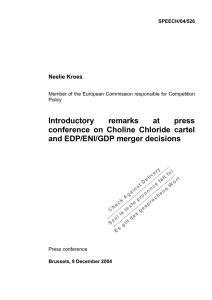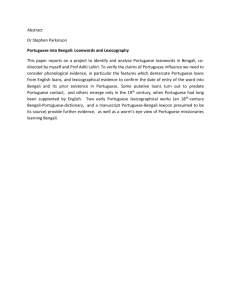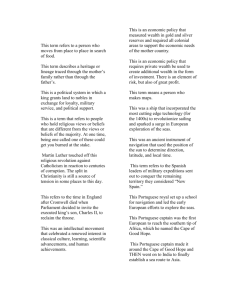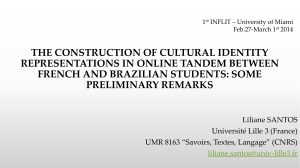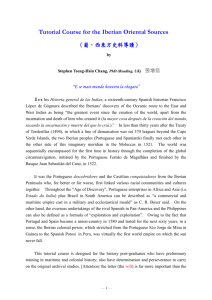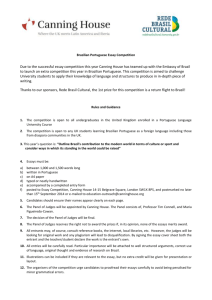Teaching Portuguese to Brazilian Students at a Secondary School
advertisement
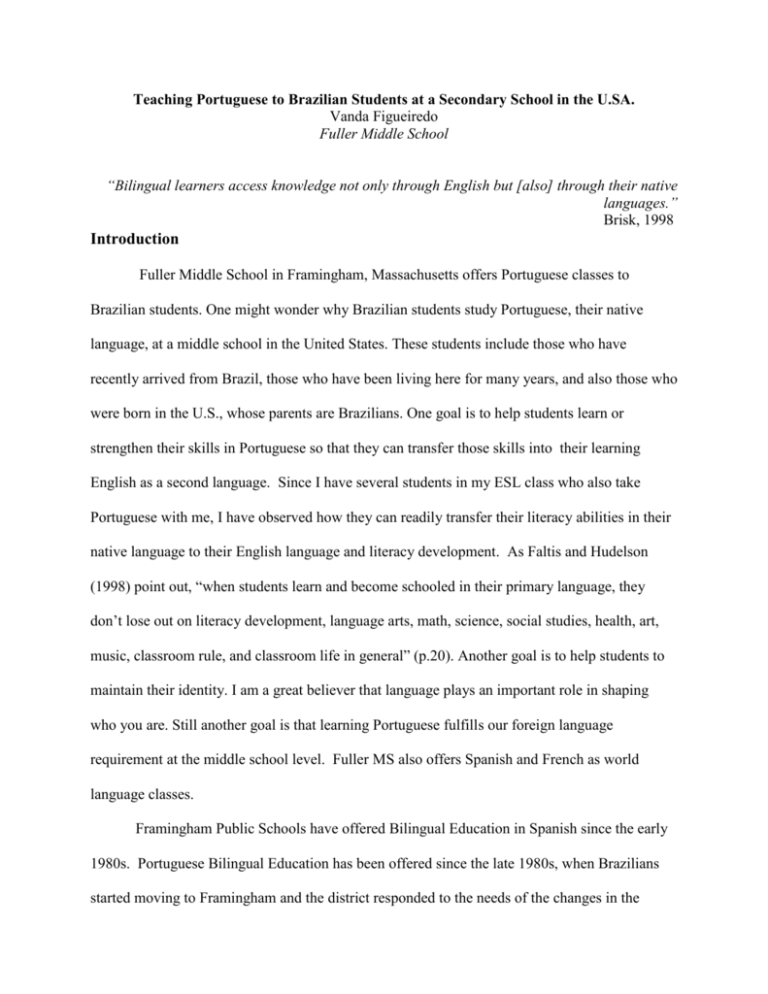
Teaching Portuguese to Brazilian Students at a Secondary School in the U.SA. Vanda Figueiredo Fuller Middle School “Bilingual learners access knowledge not only through English but [also] through their native languages.” Brisk, 1998 Introduction Fuller Middle School in Framingham, Massachusetts offers Portuguese classes to Brazilian students. One might wonder why Brazilian students study Portuguese, their native language, at a middle school in the United States. These students include those who have recently arrived from Brazil, those who have been living here for many years, and also those who were born in the U.S., whose parents are Brazilians. One goal is to help students learn or strengthen their skills in Portuguese so that they can transfer those skills into their learning English as a second language. Since I have several students in my ESL class who also take Portuguese with me, I have observed how they can readily transfer their literacy abilities in their native language to their English language and literacy development. As Faltis and Hudelson (1998) point out, “when students learn and become schooled in their primary language, they don’t lose out on literacy development, language arts, math, science, social studies, health, art, music, classroom rule, and classroom life in general” (p.20). Another goal is to help students to maintain their identity. I am a great believer that language plays an important role in shaping who you are. Still another goal is that learning Portuguese fulfills our foreign language requirement at the middle school level. Fuller MS also offers Spanish and French as world language classes. Framingham Public Schools have offered Bilingual Education in Spanish since the early 1980s. Portuguese Bilingual Education has been offered since the late 1980s, when Brazilians started moving to Framingham and the district responded to the needs of the changes in the demographics in the town. English as a second language instruction (ESL) has been offered in Framingham since 1971- with the passing of Chapter 71A. At Fuller, Portuguese-speaking or Spanish –speaking students in ESL level 1 and 2 take math science, and social studies in their native language. I started to teach Portuguese Language Arts and English as a Second Language (ESL) at Fuller Middle School, in August 2001. Very often, my students come from areas of Brazil where they had little or interrupted schooling. Some students were born in the United States and have not previously taken Portuguese classes. A significant number of the students are able to communicate orally. They have Basic Interpersonal Conversational Skills (BICS)1 in Portuguese, but very often lack Cognitive Academic Language Proficiency (CALPS)2. This is to say that my students come to my classroom with different instructional histories, mixed language strengths and needs, varied critical thinking skills and literacy interests and preferences. Teaching Methodology My instructional practices have been greatly influenced by my knowledge and understanding of how children learn language and by my participation in professional seminars, courses in my field, conferences, as well as educational trips. I also meet weekly with my team to discuss methodologies, students’ progress and to share lesson ideas. Additionally, all of the teaching staff in the ESL/Bilingual/Sheltered English Program meet monthly to discuss the program literacy initiatives in our department and to discuss how we are employing these techniques into our teaching. In my Portuguese Language Arts classes, I have used some of the 1 BICS refers to the language proficiency acquired through interpersonal interactions (Cummings, 2001). They are not cognitively demanding as they occur in a meaningful social context. CALPS refers to the language proficiency developed through schooling and literacy throughout our lives (Cummings, 2001). CALP skills are abstract language abilities required for academic work. A more complex, conceptual linguistic ability that includes analysis, synthesis, and evaluation. 2 same reading strategies that mainstream Language Arts teachers use in their classrooms. These strategies include inferencing, visualizing, predicting, synthesizing, and questioning. My goal is to help my students to draw more meaning from texts and be better prepared academically to perform in upper grades. All three middle schools in Framingham are implementing a Literacy Grant Plan to improve the literacy skills of all students. I have translated and incorporated several of the strategies in the book Thinkquiry Toolkit I: Strategies to Improve Reading Comprehension and Vocabulary Development Across the Content Areas (Meltzer and Jackson, 2010), which is part of the district wide literacy initiative. I also provide my students with opportunities to work in small groups to discuss the texts they have read. The emphasis on reciprocal teaching and socially meaningful interactions promotes the development of Cognitive Academic Language Proficiency (CALPS). This approach to teaching is very important for bilingual students who depend on schooling to acquire models of participation in a mainstream context. In my lessons, I incorporate the Communicative Language Teaching Approach, which emphasizes comprehension and integration of listening, speaking, reading, and writing. I use a wide variety of materials to stimulate language learning: e.g., CDs, song lyrics, pictures, photographs, films, computer, and texts. I have also employed the Sheltered Instruction Observation Protocol (SIOP). This method emphasizes students’ interaction, language production, and comprehension. It consists of displayed statements of language and content objectives, supplementary materials, and it builds on students’ prior knowledge to understand new concepts and vocabulary (Echevarria, Short, & Vogt 2008). Prior to reading a passage, I preview vocabulary with my students, get them to talk about the words and use visuals to represent concepts. When teaching writing, I provide my students with extensive scaffolding and modeling. For example, I use graphic organizers, such as Venn diagrams and paragraph frames, when teaching the students the concept of compare and contrast. I also provide them with sentence starters and language frames to help them organize their thoughts and use academic vocabulary in meaningful ways. Furthermore, I have strived to integrate multicultural topics into my teaching including immigration, racism, environment preservation, child labor, Brazilian culture and history, globalization, and social inequality. In my Portuguese Language Arts classes, I employ thematic units around these topics. I emphasize global studies by choosing readings that reflect other parts of the world. Literature is an important vehicle for getting students to learn more about the wider world. For example, this year, in my sixth grade Language Arts class, we studied the geography and culture of the Middle East while reading the book entitled Mohamed um menino Afegão by Fernando Vaz. This book chronicles the story of an Afghani boy named Mohamed narrating his life experience during war in his country. In grade eight Portuguese Language Arts, I teach a unit on the Holocaust. The class read the book O diário de Anne Frank a translation of The Diary of Anne Frank by Anne Frank and watched the film as well. The students also read Noite a translation of Night by Elie Wiesel in which he tells his experience in the Nazi concentration camps Auschwitz and Buchenwald during the Holocaust. Throughout this unit, we read several non-fiction articles and watched movies around the same topic. For instance, this year, the class watched the film O menino do pijama listrado a translation of Boy in the Striped Pajamas (2008) set during the WW II. Moreover, they watched the documentary Mensagens para um mundo mais tolerante (2007). This is film of testimonies of Holocaust survivors who, nowadays, live in Brazil. This documentary promotes the engagement of students in critical and cognitive discussion of tpoics such as diversity, prejudice, discrimination, and tolerance. The discussion of such themes is an opportunity to connect knowledge to respect of diversity. One advantage of a global curriculum is that it teaches our student that they are citizens of the world rather than of a single country. Furthermore, this approach to teaching becomes important as globalizing forces increasingly bring people together. Connecting Students to Brazil As part of a school wide effort to invest in technology, I have recently been awarded a Mimio, which transforms my regular white board into an interactive white board. It has improved my lessons and increased students motivation and engagement. The use of technology has significantly helped me to connect my students to Brazil in real time. I have used You Tube, Rede Globo’s homepage, UOL Educação online, and Folha de Sao Paulo online in my lessons. Prior to President Barrack Obama’s recent visit to Brazil, I accessed Folha Online and read several articles about his visit with my students. I used multimedia resources and my students wrote essays, which discussed the President’s experience in Brazil. They also wrote predictions about Obama’s speech to the Brazilian people. At the end of his visit, we read his speech and watched a video with the highlights of his visit. The students checked and discussed their predictions in groups. The students enjoyed these lessons as they were highly engaged in their learning during these activities. In February 2007, I ventured out on an Earthwatch Institute’s Conservation Initiative to the Pantanal region of Brazil. I traveled with scientists and a group of educators from different school districts to research amphibians and reptiles. I prepared a series of lessons, in English and Portuguese, about my research and posted them on my webpage, so that I could keep in touch with my students daily. I kept online journals and updated a blog every night while in Brazil. My students completed the activities online, read my blog and e-mailed me questions during the trip. In addition, the students enjoyed participating in a teleconference with me. These real-life experiences were both meaningful and enlightening to my students. I returned to my classroom with a great desire to continue educating my students about their role and responsibility in preserving and respecting our planet. I engaged my students in a series of research projects about global warming and environment conservation. Challenges and Outcomes My challenges include, acquiring meaningful materials, addressing my students’ needs and interests, and maintaining their motivation to continue to study Portuguese. It requires a continuous labor-intensive effort to adapt the materials geared to the Brazilian context to the U.S. context and to prepare lessons that fully engage my students in their learning. Translation of materials from English to Portuguese is a significant part of my job. In doing so, I try to align my curriculum to the English Language Arts curriculum. I teach skills that my students need to learn in mainstream classes. I also familiarize my students with different literary genres, which is a way to foster critical thinking skills and help them to acquire background knowledge and motivate them to write their own texts in these genres. Throughout these ten years that I have been teaching at the Fuller Middle School I have strived to build a small classroom library of books in Portuguese into a larger one. The Bilingual/ /ESL/ Sheltered Program has provided me with a budget to purchase books and other teaching materials in Portuguese. Since it is almost impossible to find books in Portuguese in the United States, I have to purchase them in Brazil during my summer vacation. My classroom library now contains books that include stories and topics from Brazilian culture and traditions that are relevant to my students and families. It also has books about other topics that suit the students’ interests and needs. I have established strong and consistent student-home communication in several ways: telephone contact, parent meetings, and letters home. My students’ parents have been my partners in this endeavor. They see the value of learning Portuguese and being bilingual. In one unit of study, my students became so engaged in the reading and discussed the topics so enthusiastically at home that several parents decided to read the book too, which created thoughtful discussions within those families. Some parents wrote me letters thanking me for bringing up such relevant issues and telling me how important it is for parents to discuss these topics with their children. In addition to readings and discussions, the students engaged in projects about the books they read. A group of students acted out and videotaped scenes from the books they read and presented their work to the whole class. Conclusion Utilizing Portuguese and Brazilian culture as an educational resource to promote additive3 bilingualism, biliteracy, and biculturalism in the classroom allows students to build and maintain a relationship with the language and the cultures with which they identify. The integration of multicultural topics into the curriculum fosters a sense of identity which can develop into a natural curiosity and appreciation of the diverse society of which they are members. It is fair to assume that global literacy will lead to more intellectually mature and internationally conscious young adults. I believe that teaching global literacy and challenging students to look critically at the society in which they live alerts them to global injustice and encourages active and responsible citizenship. 3 Additive bilingualism refers to extensive support for students to maintain and develop their native language while simultaneously learning a second language. Work Cited Brisk, M. E. Bilingual Education: From Compensatory to Quality Schooling. Mahwah, NJ: Lawrence Erlbaum Associates, Inc. Publisher, 1998. Cummings J. Interview with Jim Cummings: The California Reader. Published online: Spring 2001. Retrieved from: http://ebookbrowse.com/interview-with-jim-cummins-pdfd9410225 Echevarria, J., Vogt, M.E., & Short, D. Making Content Comprehensible for English Learners: the SIOP Model. Boston, MA: Person/Allyn & Bacon, 2008. Faltis, C. & Hudelson, S. Bilingual Education in Elementary and Secondary School: Towards Understanding and Caring. Needham Heights, MA: Allyn & Bacon, 1998. MeLtzer, J. & Jackson, D. (Eds.). Thinkquiry Toolkit I: Strategies to Improve Reading Comprehnsion and Vocabulary Development Across Content Areas. Portsmouth, NH: Public Consulting Group, 2010.

